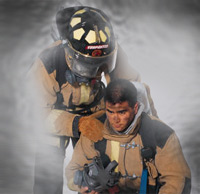Smoke inhalation occurs as a result of breathing in poisoning gases, soot or smoke from a fire nearby. Smoke contains toxic substances such as carbon monoxide that inhibits the body’s oxygen supply. Moreover, prolonged exposure to smoke can also cause lung damage, damages to the airways and poisoning from the chemicals absorbed in the lungs. The leading cause of deaths related to fire, are not caused due to getting burnt or injured by the fire, but inhaling its smoke alone.
A person suffering from smoke inhalation may experience symptoms such as wheezing, breathing difficulties, headaches, chest pain, fainting and cyanosis. Prolonged exposure may result in coma or even death.
Smoke inhalation is often treated at the hospital using oxygen therapy, intravenous fluids and bronchodilator medications. People suffering from severe smoke inhalation may be kept under a ventilator for breathing support.
Important Disclaimer: this post on smoke inhalation is for learning purposes only. To learn about recognizing and managing breathing emergencies and inhaled poisons enrol in workplace approved first aid and CPR classes.
Causes
Smoke from fire contains a low oxygen amount and a very high amount of carbon dioxide and carbon monoxide, which deprives the body of its oxygen supply. There are many other chemicals in smoke that may be toxic to 
The following are some toxic chemicals that may be present in smoke:
- Ammonia
- Carbon monoxide
- Chlorine
- Cyanide
- Hydrogen chloride
- Phosgene
- Sulfur dioxide
Signs and symptoms of smoke inhalation
- Nausea and vomiting
- Headache
- Difficulty breathing
- Hoarse voice
- Chest pain
- Wheezing
- Cough
- Recurrent vomiting
- Cyanosis—bluish discoloration of the lips
- Lethargy and drowsiness
- Generalized weakness
- Confusion
- Coma
- Fainting
Serious Emergency Treatment
Call 911 immediately. Get emergency medical help if;
- Te casualty is unconscious
- The casualty is confused or dizzy
- The casualty is choking violently and coughing
- The casualty is suffering from chest pain and chest tightness
- The casualty is wheezing or is suffering from shortness of breath
- The casualty has smoke or ash on his face, around the mouth or nose
- The casualty has swollen airways
- The casualty’s voice is hoarse
- The casualty has burns in the nose, throat or mouth
- The casualty is having difficulty seeing properly or is experiencing dual or blurry vision
- The casualty is numb on the extremities
Treatment
- Take the casualty to a safe zone, somewhere outside where there is fresh air. Allow the casualty to lie down. Avoid lying him down on the back if he is vomiting or coughing up any fluids, let him rest on his side so the fluids can drain off
- Give CPR immediately if the person is not breathing
- Check for signs of shock such as clammy skin, sweating, glazed eyes, rapid shallow breathing, vomiting and dizziness. Do not give anything to eat or drink
- Give the causally oxygen, if available
- Take the casualty to the emergency room immediately even if he is not experiencing any symptoms of damage. Symptoms of smoke/toxin inhalation begins to show after hours of exposure, after which is worsens rapidly
Learn More
To learn more about breathing emergencies and poisons enrol in a workplace approved first aid course near you (more information).
Related Video
http://www.youtube.com/watch?v=2Wa9X208NRE
